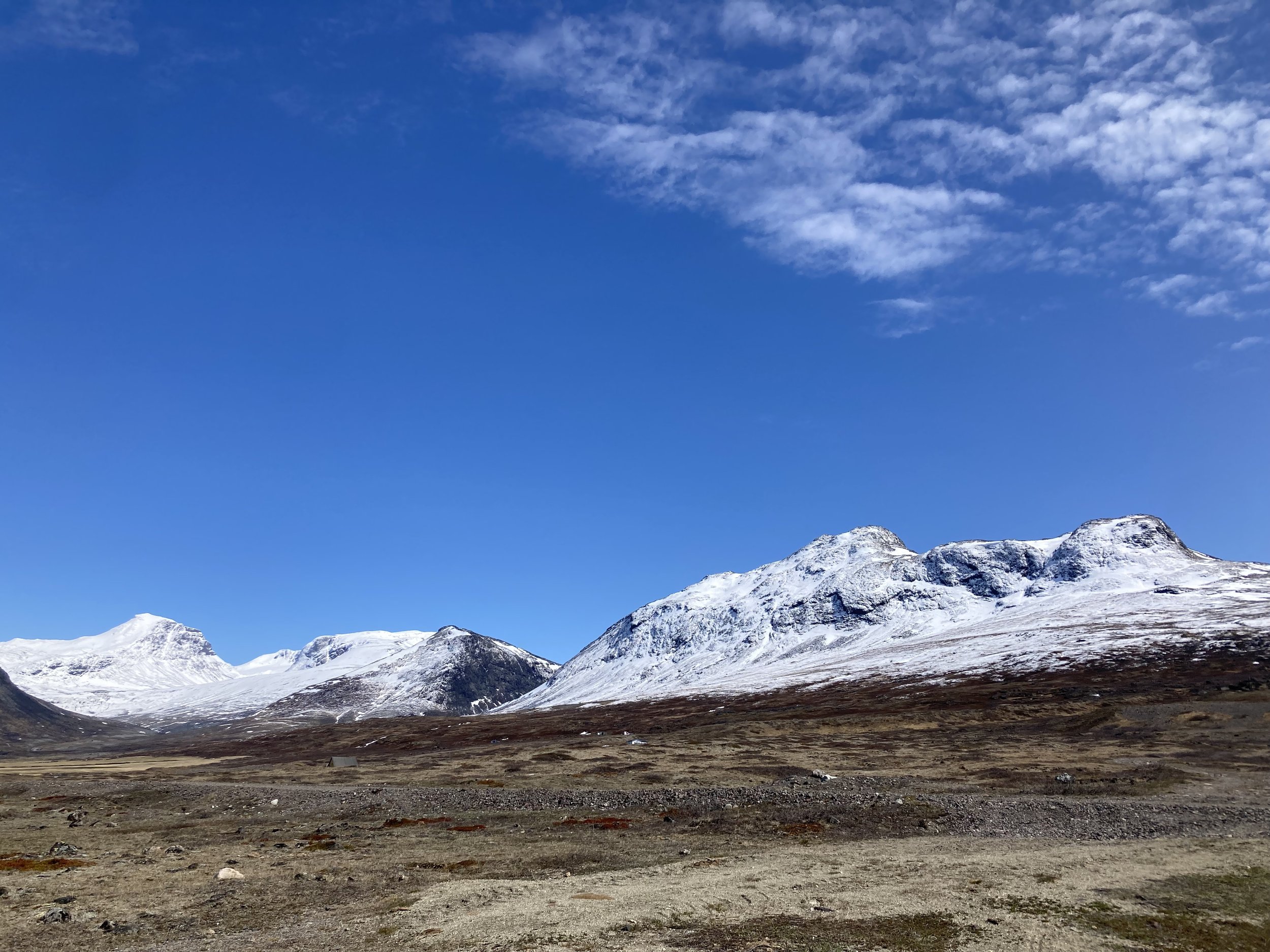
SILA: Inuit Culture and Arctic Sustainability - Royal Geographical Society
Eleanor Havsteen-Franklin, Naja Abelsen (GL/DK) and Susie Hamilton (UK) at the RGS November 2023.
Eleanor was the exhibition and project lead, including facilitating and co ordinating children’s workshops in the UK and Greenland. The exhibition at the RGS featured art works inspired by the natural world of Greenland/ Kalaallit Nunaat, their forefather’s Arctic work, Inuit culture and children’s workshops. The exhibition and project underscored the intersection of arts, culture and environmental advocacy, promoting public engagement and cross-cultural dialogue. Together with Naja Abelsen she had a residency at NIRS in Greenland, and with Susie Hamilton she held a ‘Be Inspired ‘ talk at the RGS https://www.rgs.org/events/talks-on-demand/sila-exploring-inuit-culture-and-sustainability

The exhibition highlights the significance of sustainable living and the protection of biodiversity through the lens of Inuit culture, as well as raising awareness of Greenland and environmental challenges. Susie and Eleanor were given access to the RGS’s archives to research their forefather’s Arctic expeditions and activities in Greenland. By researching the legacies of their forefathers August Courtauld, Ejnar Mikkelsen and Sejer Abelsen the historical lens brings into relief the themes of Arctic expeditions, colonisation and the ongoing dialogue within Greenland regarding its cultural and geopolitical idenity and future as a colony of Denmark. Greenland is at the forefront of discussions on climate change, and the exhibition highlights it as a critical point of engagement for understanding the global climate emergency through the lens of Inuit culture and knowledge. Greenland is the world's largest island that is not a continent, 2.166 mill km2 of which about 80 % is covered in ice. It has been inhabited for centuries by Inuit, and earlier by various Arctic hunters. Today there is a population of 56.865, mainly living in the 5 cities/towns on the west and south coast with 19.770 in the capital Nuuk. The main form of transport is by boat, helicopter and plane, and in some northern places by dog sledge. Greenland has had home rule since 1979, and self governance since 2009 with Denmark retaining control of foreign affairs and defence. There is a growing debate in Greenland about its future relationship to Denmark. The debate over sovereignty interacts with challenges regarding the economy, its strategic position on the world map and sustainable resource management with its abundance of rare earth minerals, which industrialised countries are increasingly interested in sourcing to decarbonise their economies. The exhibition was kindly supported by the Rothschild Foundation and Augustine Courtauld Fund. Also thanks to the Royal Geographical Society for allowing us access to their Archives.
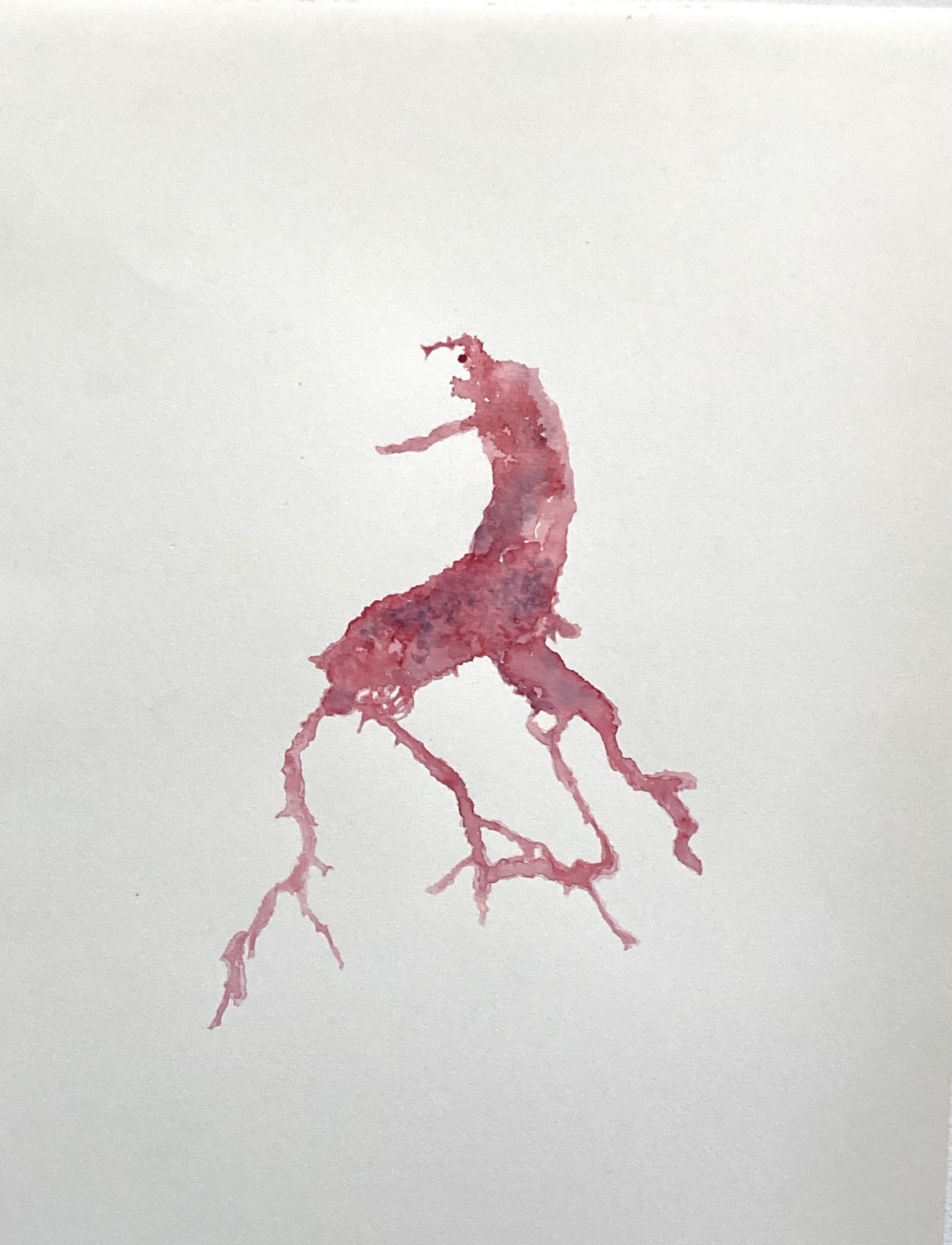
Ittoqqortoormiit/ Scoresbysund, Water colour 2023 by Eleanor. The small dot signifies the settlement of Scoresbysund, which today is known as Ittoqqortoormiit, and lays at the entrance to a large fjord system of the Greenland Sea on the remote northeastern coast of Greenland. It has a tree-like structure, with a main body that is approximately 110 km long which branches into a system of fjords covering an area of about 38,000 km². Mikkelsen, Eleanor's great grandfather, helped to establish the settlement in 1925, and its geographic strategic position was a contributing factor to awarding Denmark the governance of all Greenland in 1933, at the International Court at the Hague. this was following a long dispute with Norway over the North eastern region. Naja’s forefather Sejer Abelsen was the chief catechist (pastor) in the new the settlement. Current debates in Greenland involve the impact of colonisation and its future relationship to Denmark.

Eleanor is the great granddaughter of Ejnar Mikkelsen (1880 - 1971), who undertook several expeditions in the Arctic, including the Alabama Expedition 1909-12, captured in the film Against the Ice (2022) when he and Iver Iversen (1884 - 1968) were stranded for 28 months. The expedition to the northeast coast of Greenland aimed to recover the diaries, maps and bodies of Mylius-Erichsen and Høeg Hagens from the Denmark Expedition of 1906 - 1908. The maps were found, and their documents proved that Greenland was one island, thereby dismissing any possible territorial interest from the USA. The expeditions by Courtauld and Mikkelsen took place during a time where they were a ‘white man’s world’ and associated with patriarchy, ‘discovery' and heroic adventures. Throughout his life, Mikkelsen was actively involved with Greenland, including the establishment of the colony Scoresbysund in 1925 where Naja Abelsen’s forefather Sejer Abelsen worked as the chief catechist (pastor). Sejer Abelsen’s helped to set up this new community on the remote coast of northeast Greenland, today known as Ittoqqortoormiit. The new settlers came from Ammassalik, a settlement further south, which had been struggling with dwindling food supplies from hunting. He hoped that the settlement would support/ re establish Inuit travel and hunting routes in this remote part of Greenland, including the building of small overnight cabins between Ammassalik and Scoresbysund (Biography on EM by Kurt L Frederiksen). However, Mikkelsen's interests were also of a political and territorial nature. He writes of the crew whom he had recruited to travel ahead to build the houses for about 100 settlers, that they were all, “ready to sacrifice a great deal for Denmark's right to East Greenland, especially Scoresbysund” (Mikkelsen 1957:55) “... the new Colony, which would hopefully prove to be a strong and lasting bulwark against Norwegian [whaling/fishing] activity further north” (Mikkelsen 1934:133). Its geographical placement became one of the factors which led to the whole of Greenland officially becoming a colony of Denmark at the International Court in the Hague in 1933. During his life, Mikkelsen often seemed to be in conflict with Danish politicians in regards to Greenland (Frederiksen). He was a curious mix of deep respect for the Inuit - their culture and abilities to survive in the harsh conditions of the Arctic; always fundraising for various expeditions, projects and causes in Greenland but at the same time not questioning the colonial relationship or position of Denmark's 'right' to Greenland.

The Story of Sassuma Arnaa - the Mother of the Sea. Drawing by Ninna, year 6 Narsap Atuarfia School, Narsaq - made in a art workshop facilitated by Eleanor and Naja during their residency at NIRS. Sassuma Arnaa, a pivotal figure in Inuit mythology embodies the ocean's health, which is directly impacted by the ethical and moral choices of people. In a time when pollution signifies one of these transgressions, it resonates profoundly with modern ecological concerns. According to legend, the sea animals are created from her chopped off finger joints, so they are part of herself and easily controlled. Each wrongful act by a human— whether it be a modern-day pollutant or an ancient breach of taboo—manifests as filth entangling the hair of the Mother of the Sea, trapping the creatures within and bringing famine upon the Inuit as the sea's bounty is withheld. Driven by desperation, a shaman (also called an angakkog) would embark on an arduous journey to the sea's depths, confronting Sassuma Arnaa in her underwater dwelling. Confrontation turned into a battle of wills, as the shaman grappled not only with her fury but also with her tangled, unkept locks. With no fingers to free herself from the matted brine, her anger raged like the tempestuous sea. It was only through the shaman's perseverance, combing out the knotted mass amidst their struggle, that he could appease her. As the last of the dirt fell away and the marine life once again swam free, her rage subsided, replaced with tranquillity. With the ocean's equilibrium restored, the Sassuma Arnaa shared her wisdom with the shaman, imparting lessons of balance and respect that humans must uphold to maintain harmony with nature. This narrative underscores a lesson of reciprocity and care, guiding us to a balanced and respectful coexistence with the natural world.
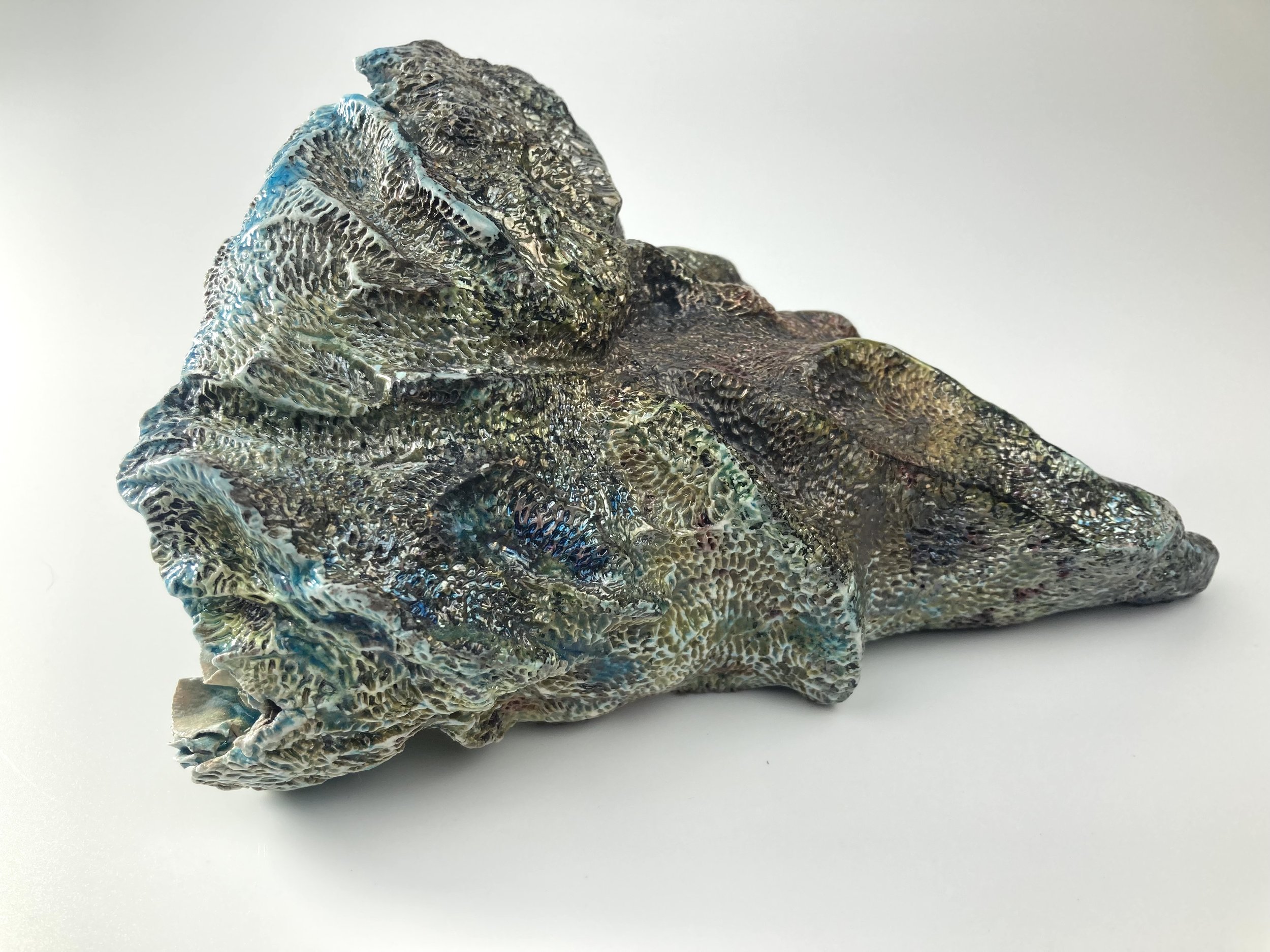
Terrae II, Porcelain 2023. The Greenland subsoil contains a variety of valuable minerals, including rare earth metals, precious metals, precious stones, coal, graphite and uranium. So far, mining has extended to coal, gold, silver, copper, rubies, graphite, cryolite, olivine and marble. The issue of future mining is heavily debated in Greenland. It’s potential impact on the environment, Greenlandic economy, nationalism and independence from Denmark are part of an ongoing debate.
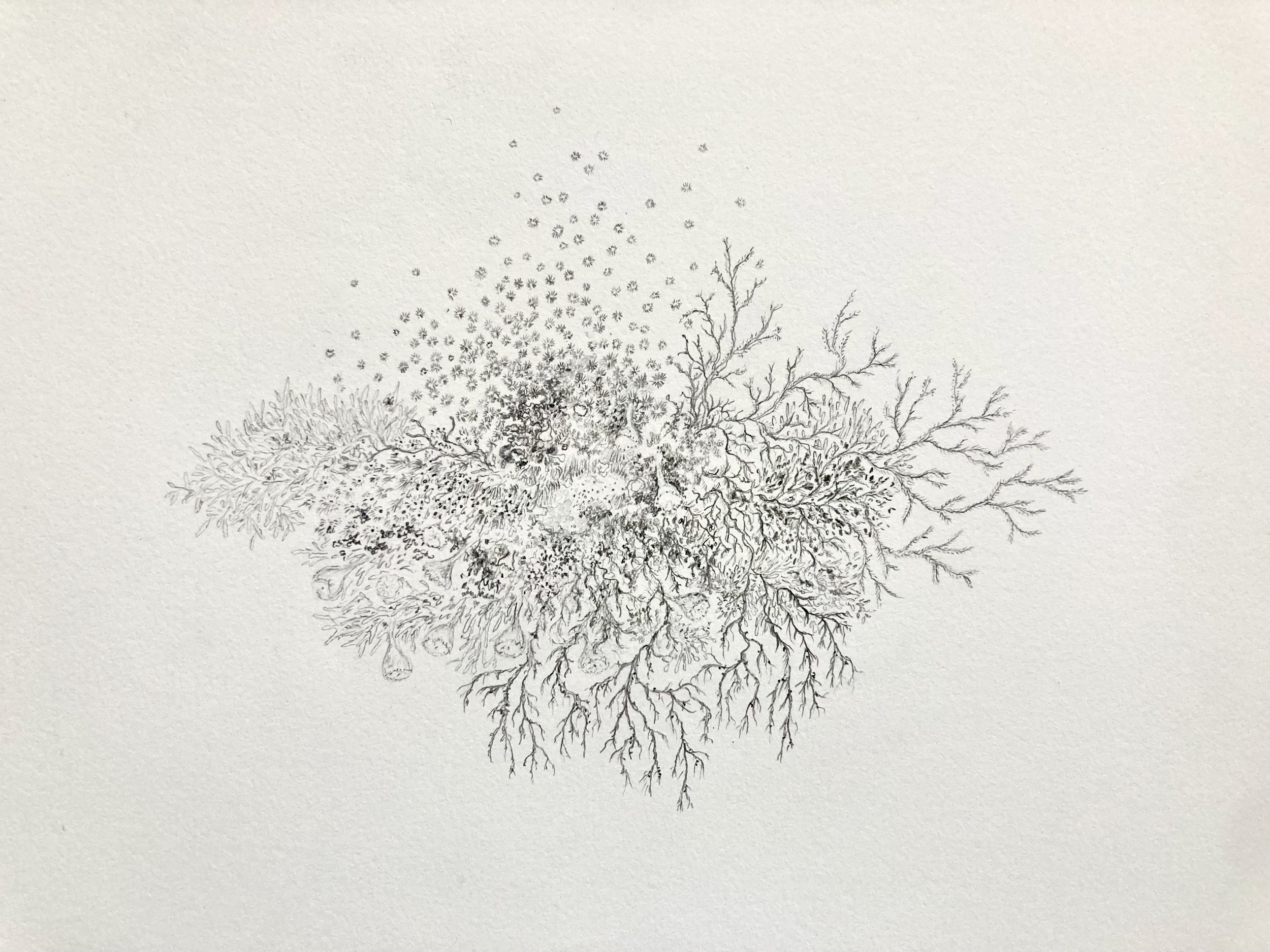
Vasculum, Drawing 2023. Inspired by willow (low growth), lichen and mosses in Narsaq. The first organisms to appear in areas of primary succession are often mosses or lichens. Primary succession is the beginning step of ecological succession after an extreme disturbance, which usually occurs in an environment devoid of vegetation and other organisms. These organisms are known as pioneer species because they are the first species present; pioneer species must be hardy and strong. Lichen are a combination of an algae and a fungus. The fungus provides a structure for the algae to live in, while the algae provides food for the fungus. Mosses are part of the informal group Bryophytes. They are non-vascular plants, which means they have no roots or vascular tissue, but instead absorb water and nutrients from the air through their surface (e.g., their leaves). The Inuit used moss and lichen for fire lighting bedding, nappies, medicine and wound dressing because of its antiseptic properties.
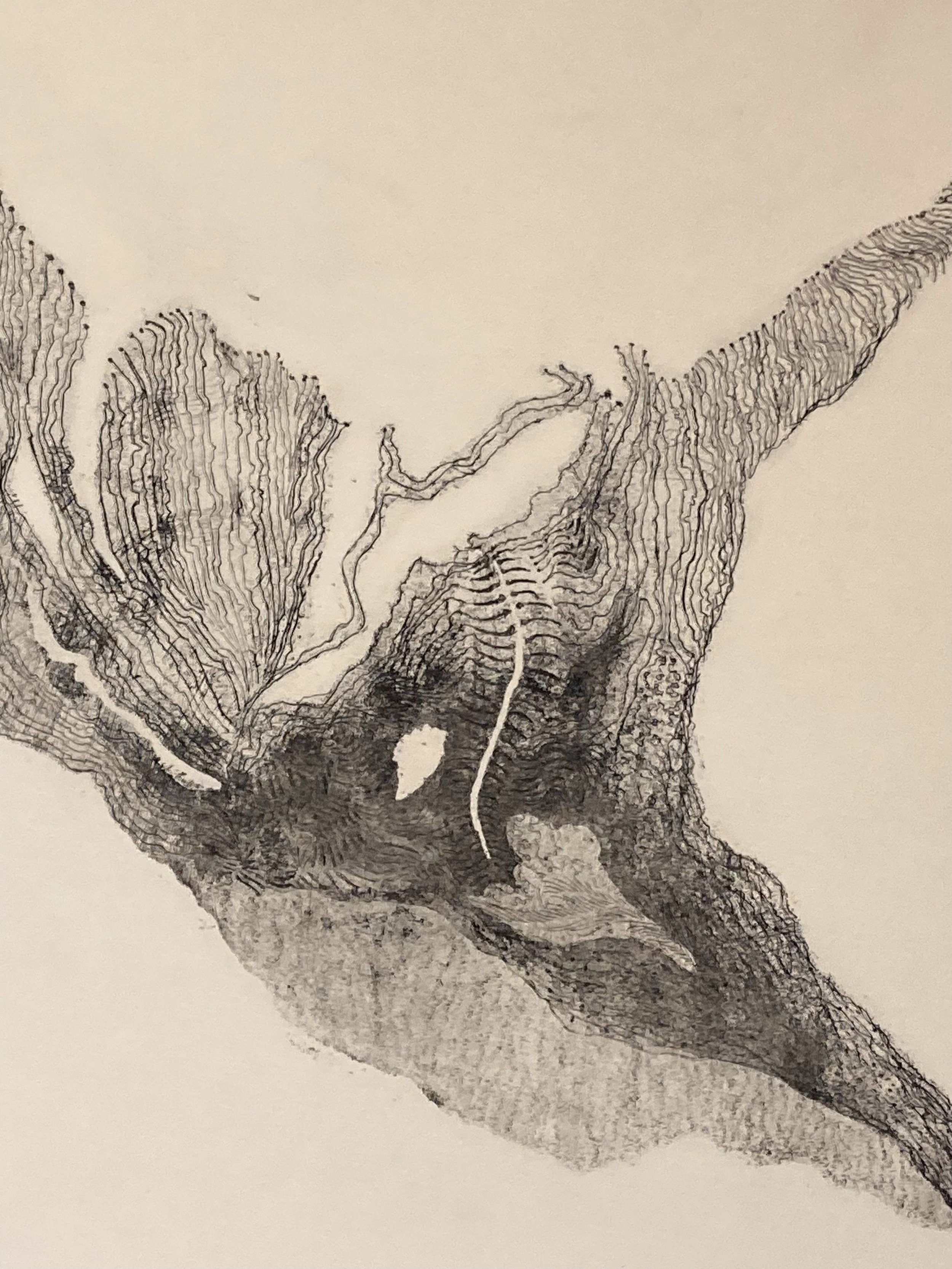
Cryosphere - detail, Etching 2023. Greenland is predominantly ice, covering 80 % of its surface. As the ice continues to melt, there are concerns that the Arctic Ocean is becoming warmer and saltier, otherwise referred to as ‘spicier’, this has a huge impact on the formation of sea ice and marine life. The glaciers host a unique microbial ecosystem, and the melting ice is releasing the microbial species that inhabit it’s surface. Researchers are studying the microbes found here, such as different bacteria, and their potential for future antibiotics but also concerns for potential pathogens. Furthermore, in terms of conservation, rising temperatures and withdrawing permafrost have led to concerns about the biological degradation; researchers are concerned about its impact on cultural artefacts and the natural history found in the natural environment, which have been preserved for several thousands of years.
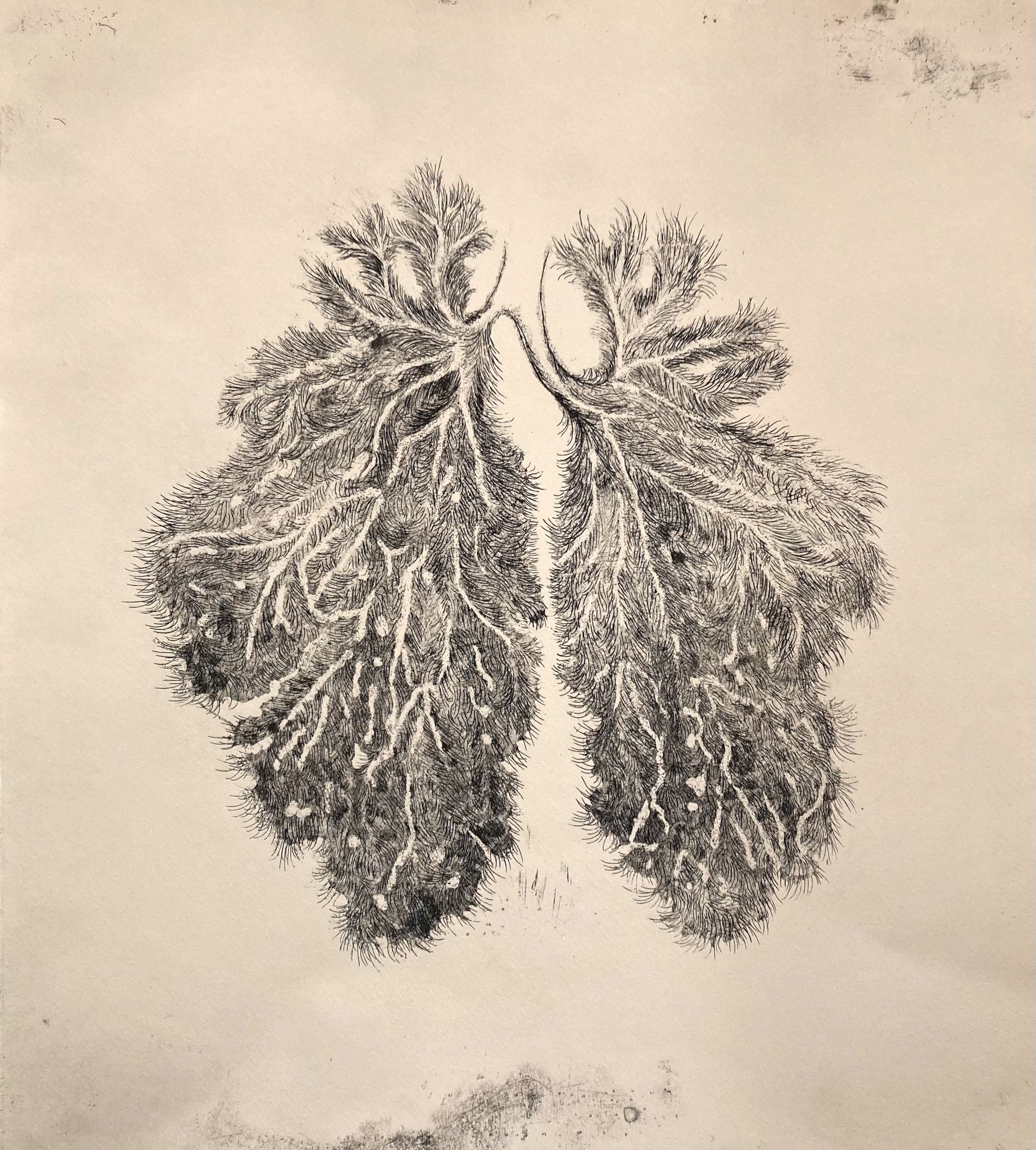
Cappilus II, Etching 2023. Inuit culture, deeply intertwined with the vitality of mammalian fur, mirrors the essentiality of human lungs, with fur symbolizing a life-sustaining element crucial to their survival and cultural identity.
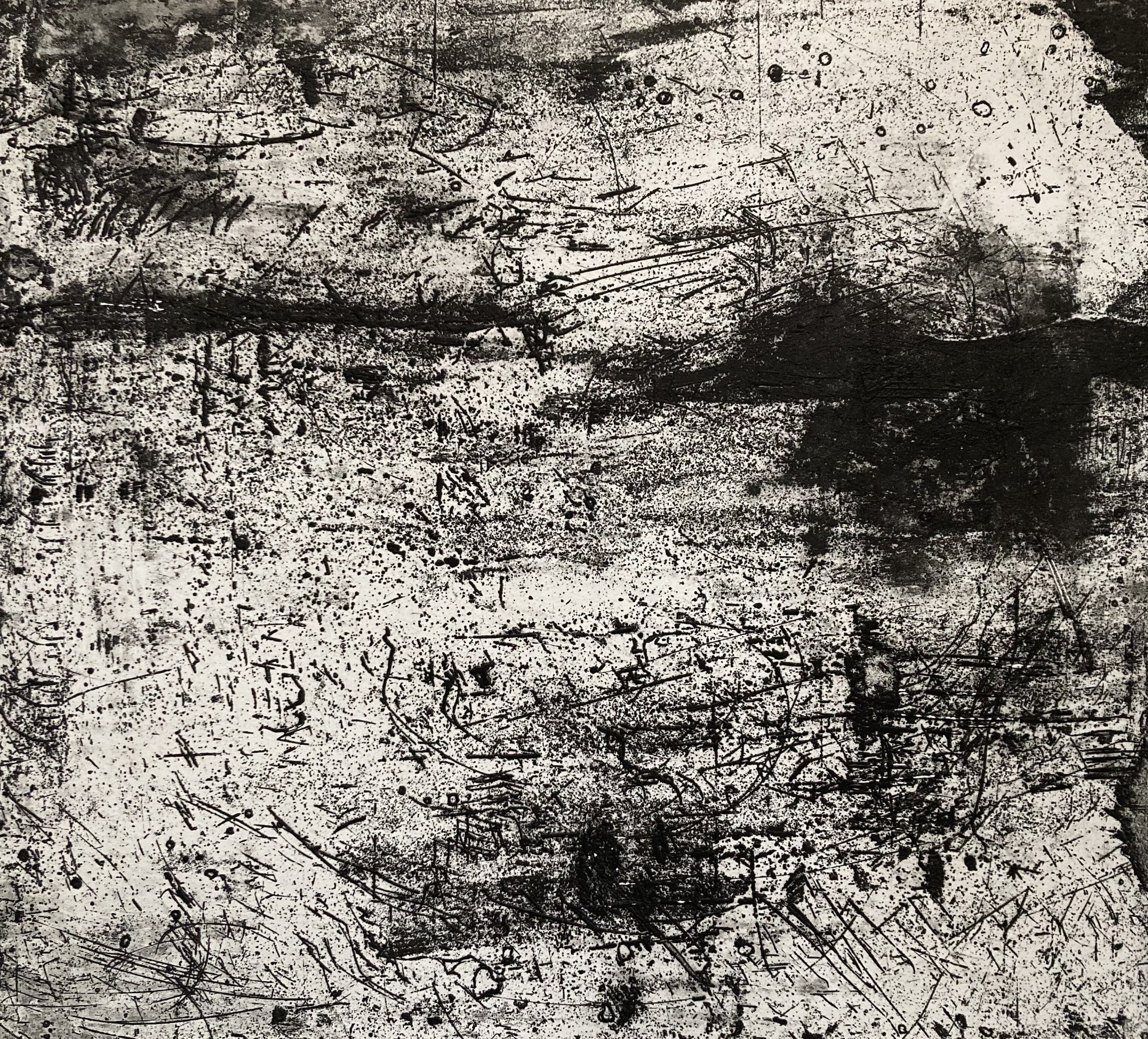
Tenebris, Etching 2023. Greenlandic landscape. Silt, also known as rock flour or glacial flour, is the sediment from rock and gravel particles produced during glacial erosion; created by the grinding of bedrock, silt is found everywhere in Greenland in very large quantities. Researchers have found that it holds great potential: not only is it very effective as an organic fertiliser, it is also able to draw large amounts of CO2 out of the atmosphere, thereby counteracting some effects of climate change.
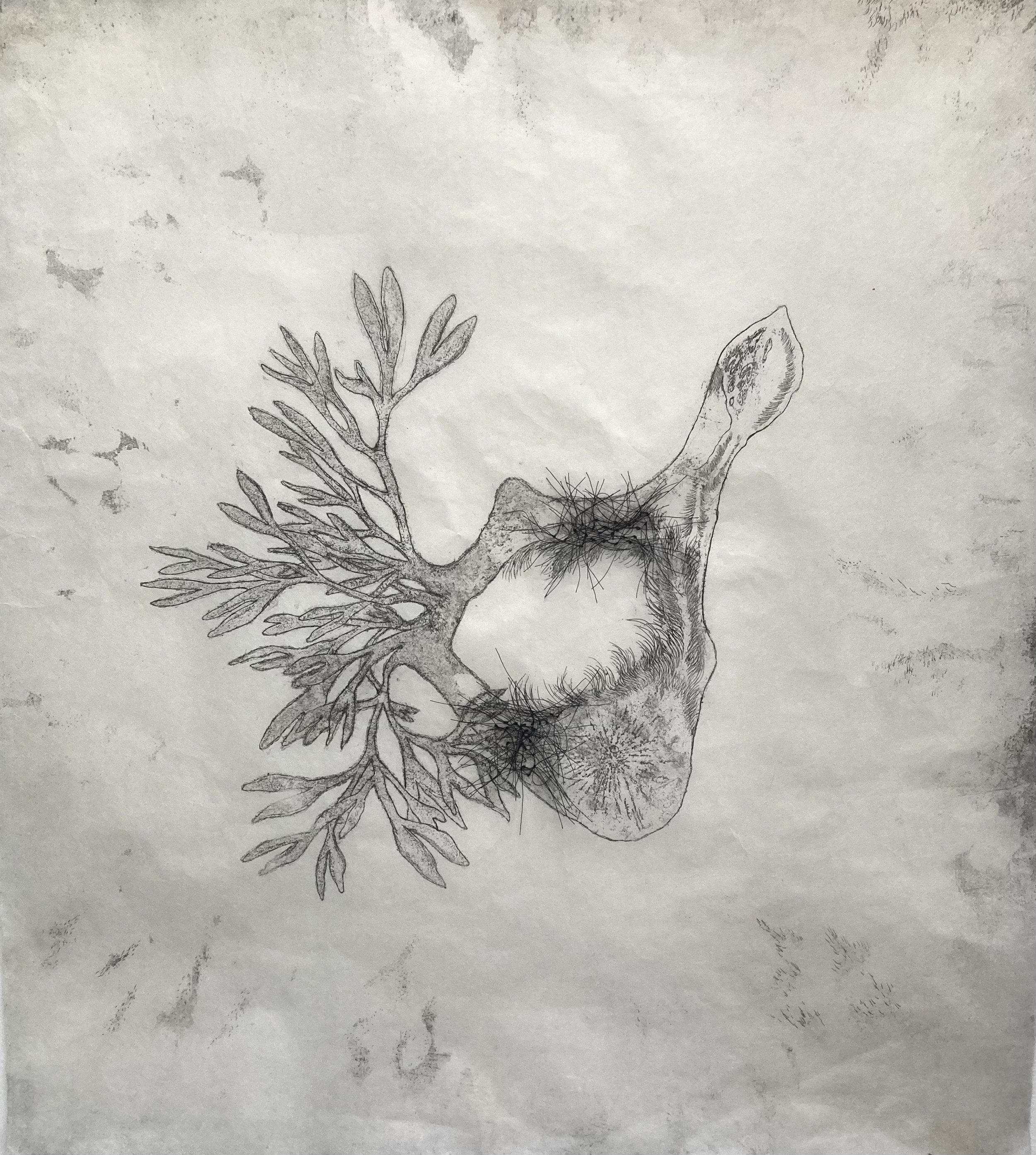
Formis, Etching and thread on Japanese paper 2023. Inspired by animal bones and seaweed The Inuit used all parts of the mammal; the meat for food, bones for tools and decorations, and the fur for making clothing, boats, shelter, rope etc. Seaweed is a traditional food in Greenland, considered a “superfood” for its nutritional density and recognised as a sustainable food source. Various species of seaweed grow along the entire coast of Greenland. Seaweed can be used directly for human consumption and its composition can be used to obtain a wide range of substances for the food and cosmetic industries. There is a growing interest in harvesting seaweed, and the possibilities of commercial seaweed farming are being explored and investigated, making it a possible new source of income.
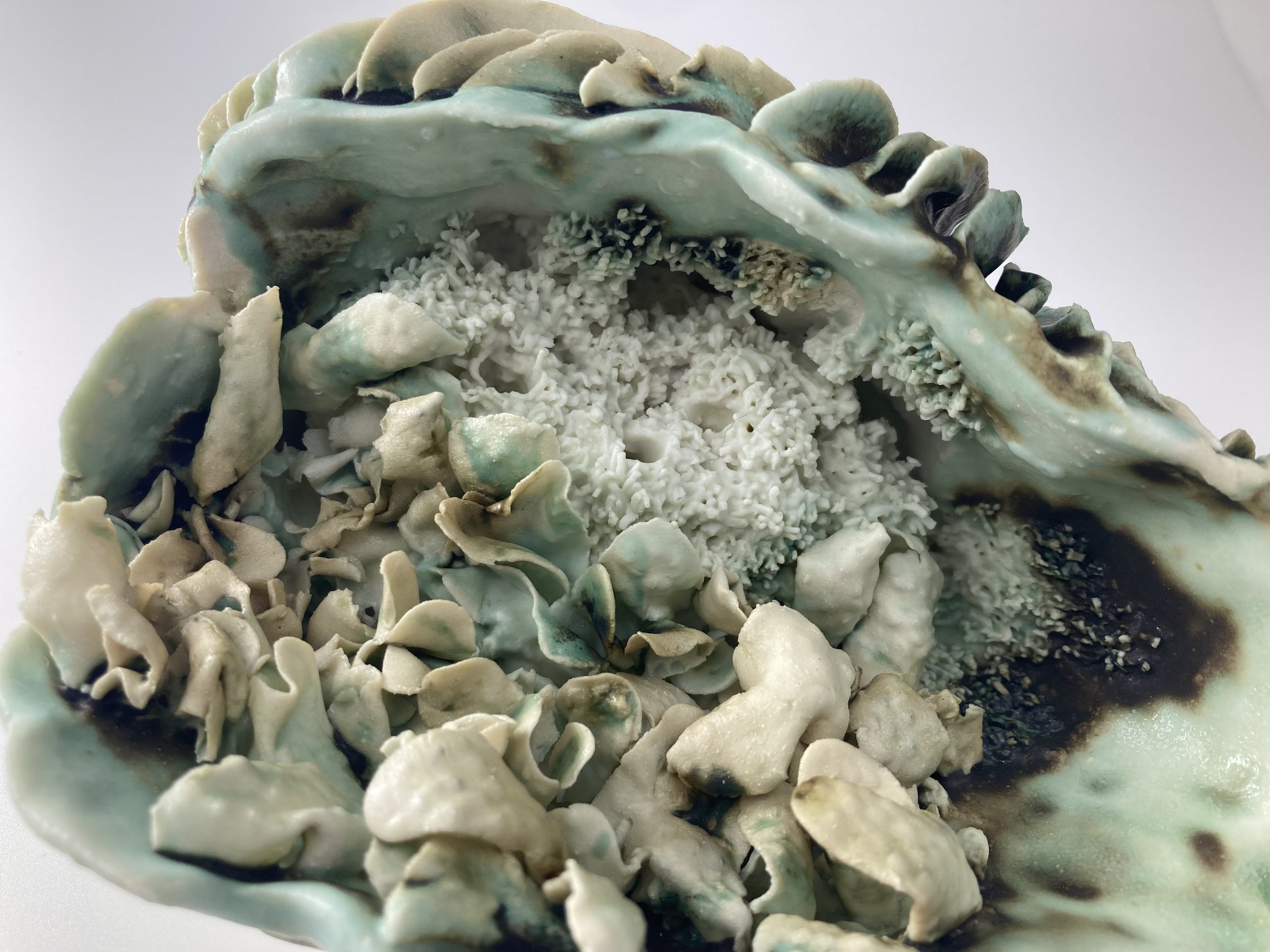
Sub mari, Porcelain 2023. Inspired by sea weed which is a traditional food in Greenland. It is considered a “superfood” for its nutritional density and recognised as a sustainable food source. Various species of seaweed grow along the entire coast of Greenland. Seaweed can be used directly for human consumption and its composition can be used to obtain a wide range of substances for the food and cosmetic industries. There is a growing interest in harvesting seaweed, and the possibilities of commercial seaweed farming are being explored and investigated, making it a possible new source of income.

Susie Hamilton, Greenland Shark, Acrylic on cardboard, 2023
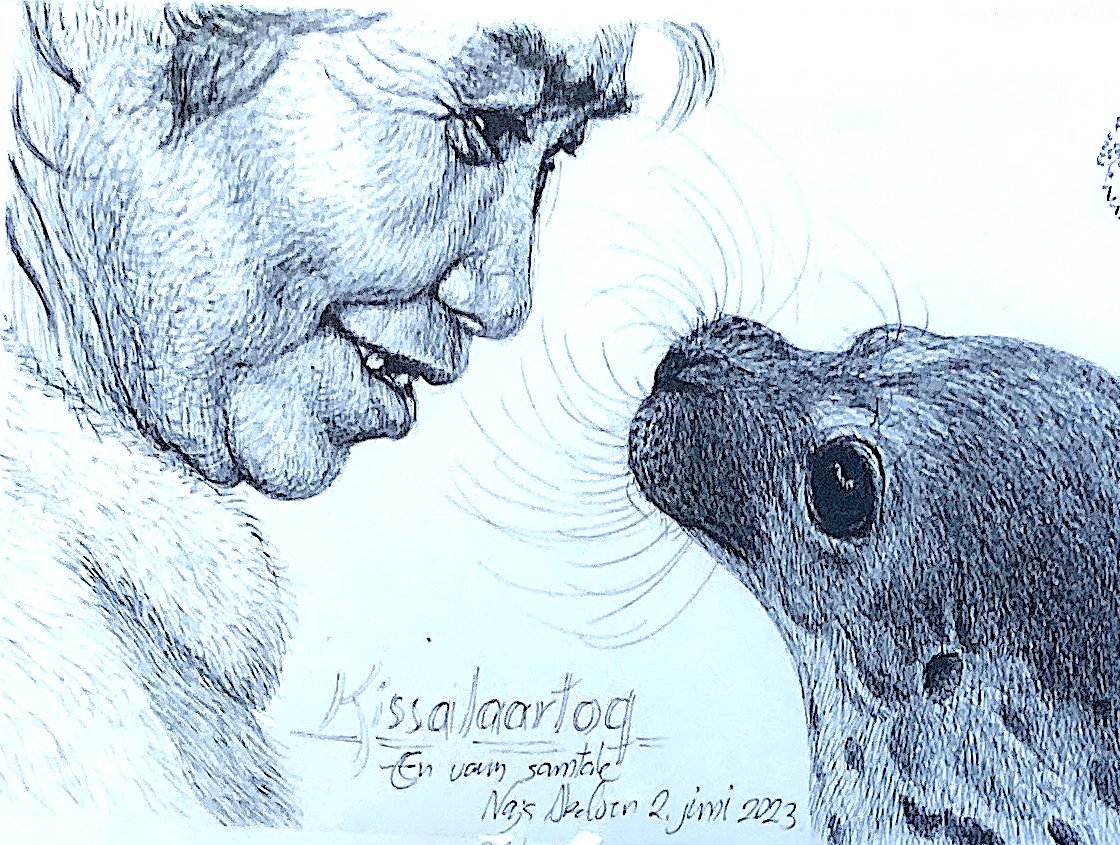
Naja Abelsen, Kissalaartoq, Pigment pen 2023. Kissalaartoq, meaning a warm conversation. This drawing embodies Naja's recent research trip to Greenland: 'so many warm, interesting conversations and meetings with people, so much knowledge shared with Eleanor Havsteen-Franklin and myself. Being there and able to draw has fulfilled a deep yearning for my father´s country, my childhood country....'
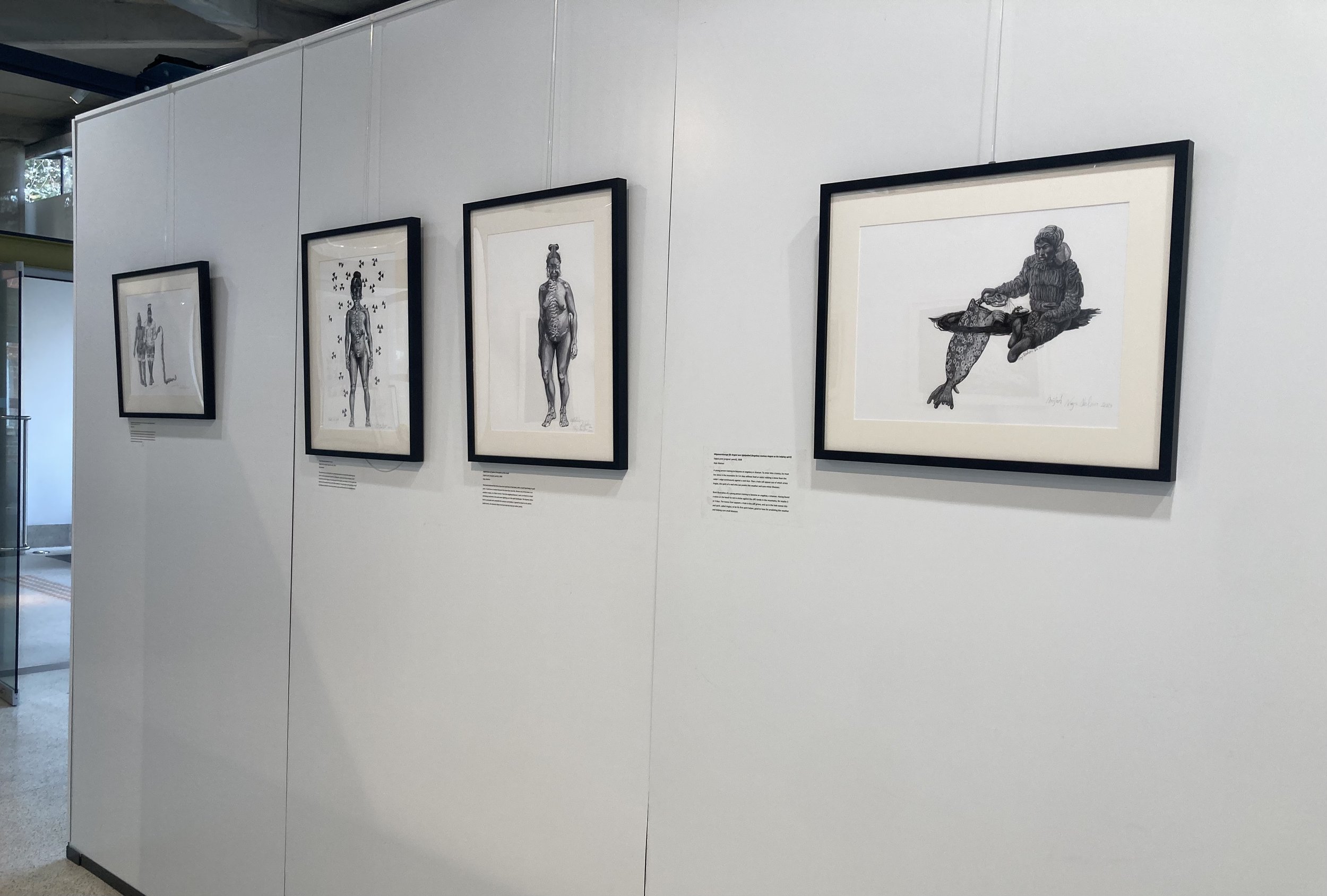
Royal Geographical Society
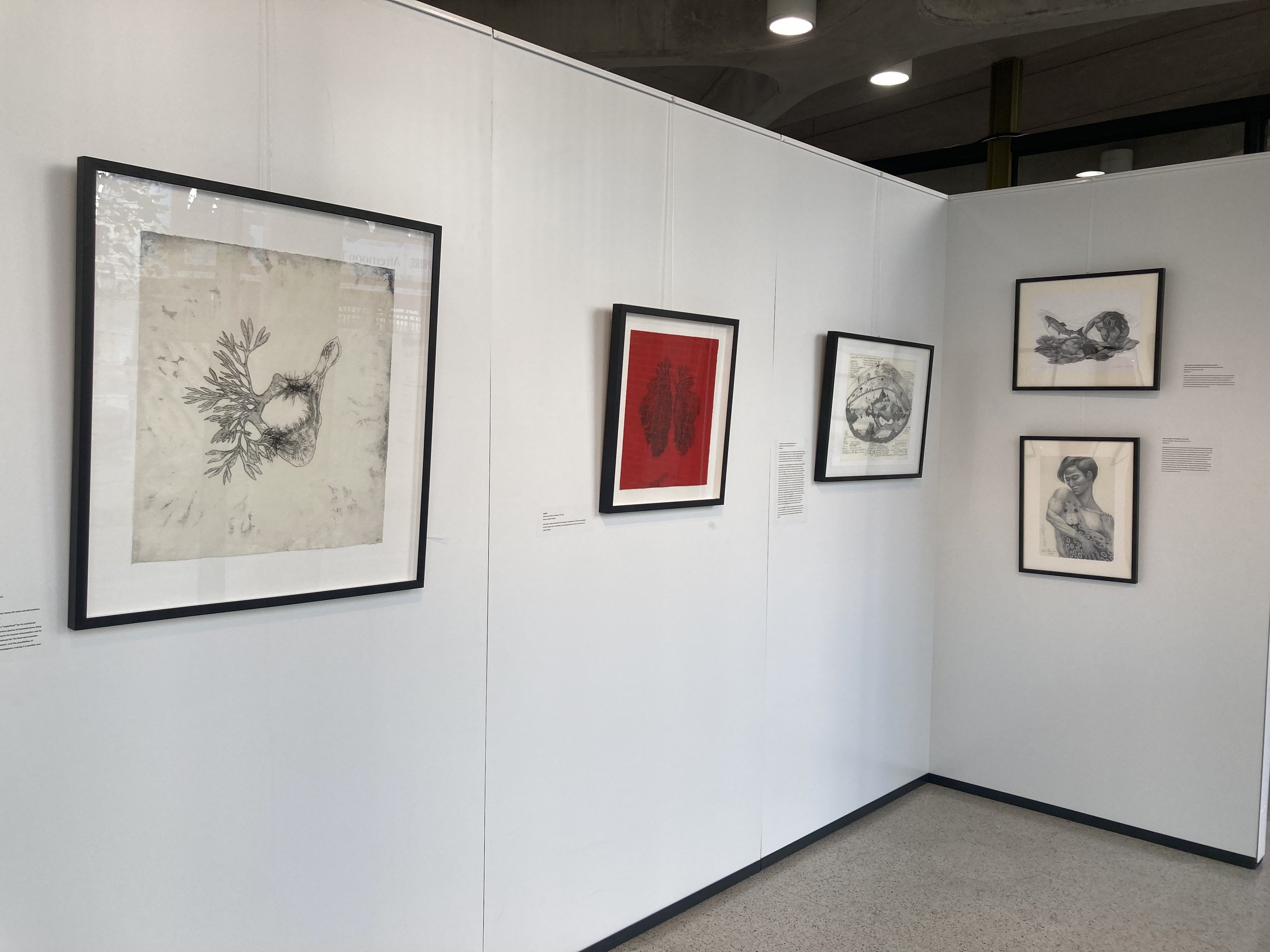
Royal Geographical Society
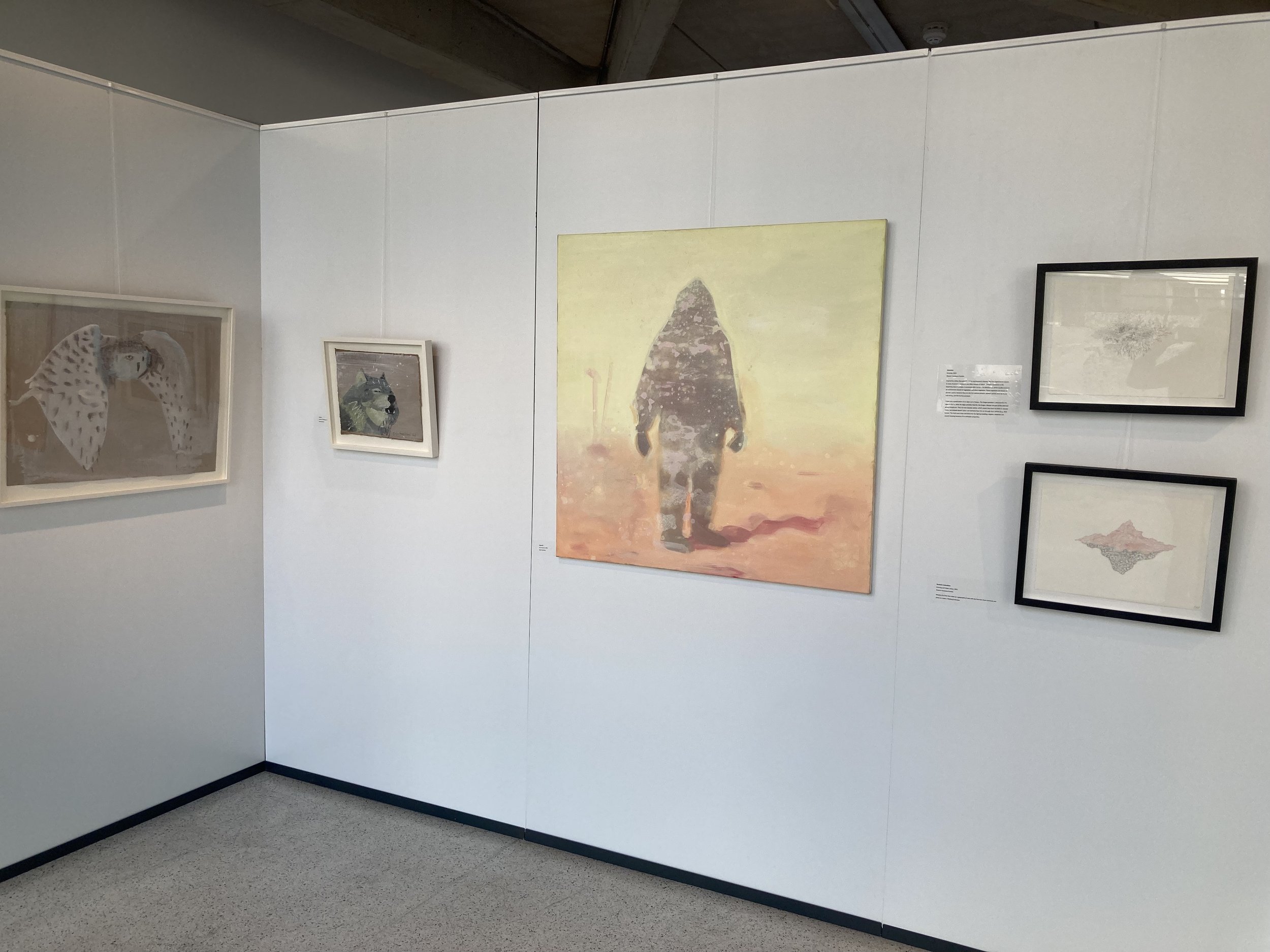
Royal Geographical Society
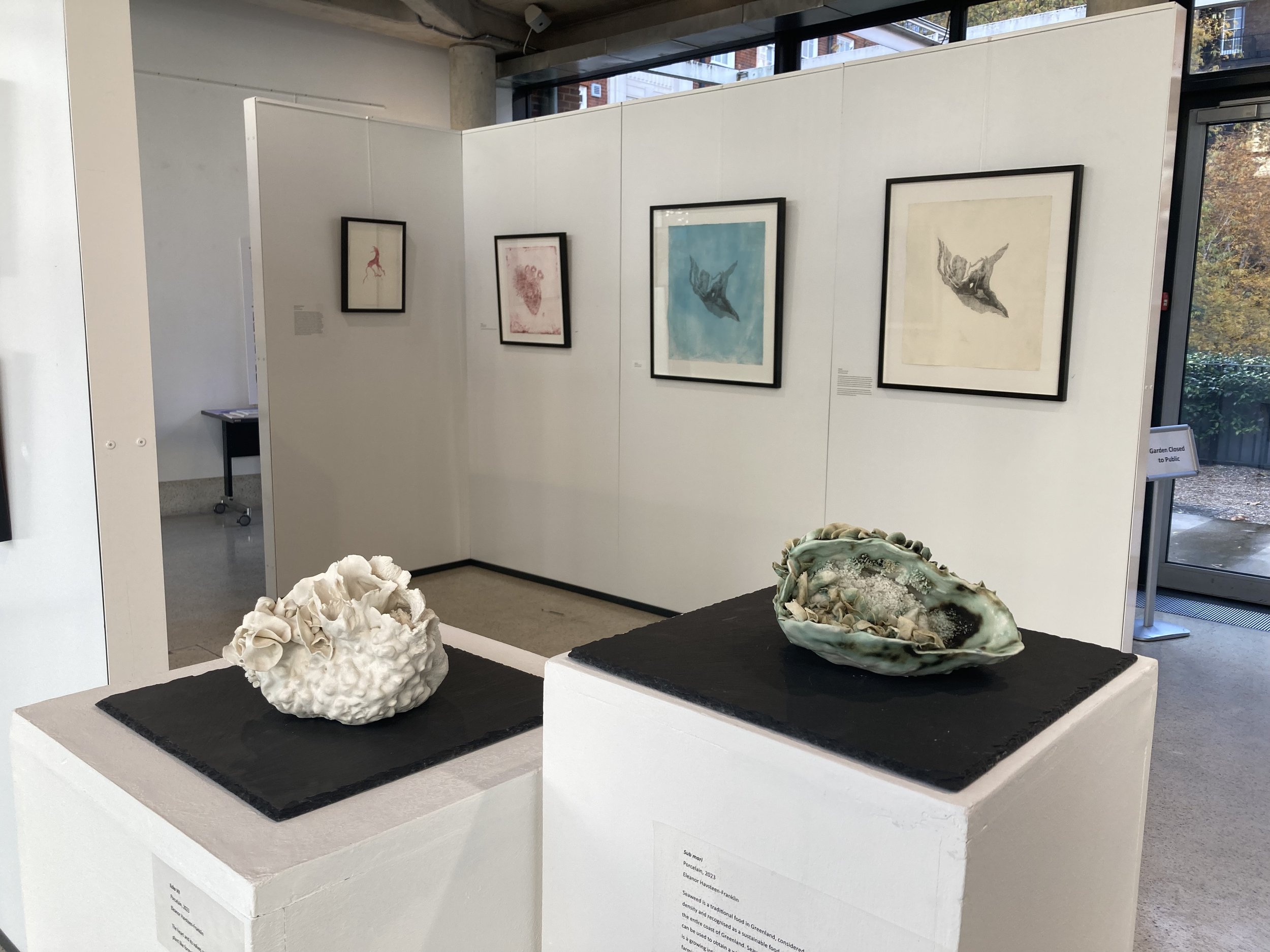
Royal Geographical Society
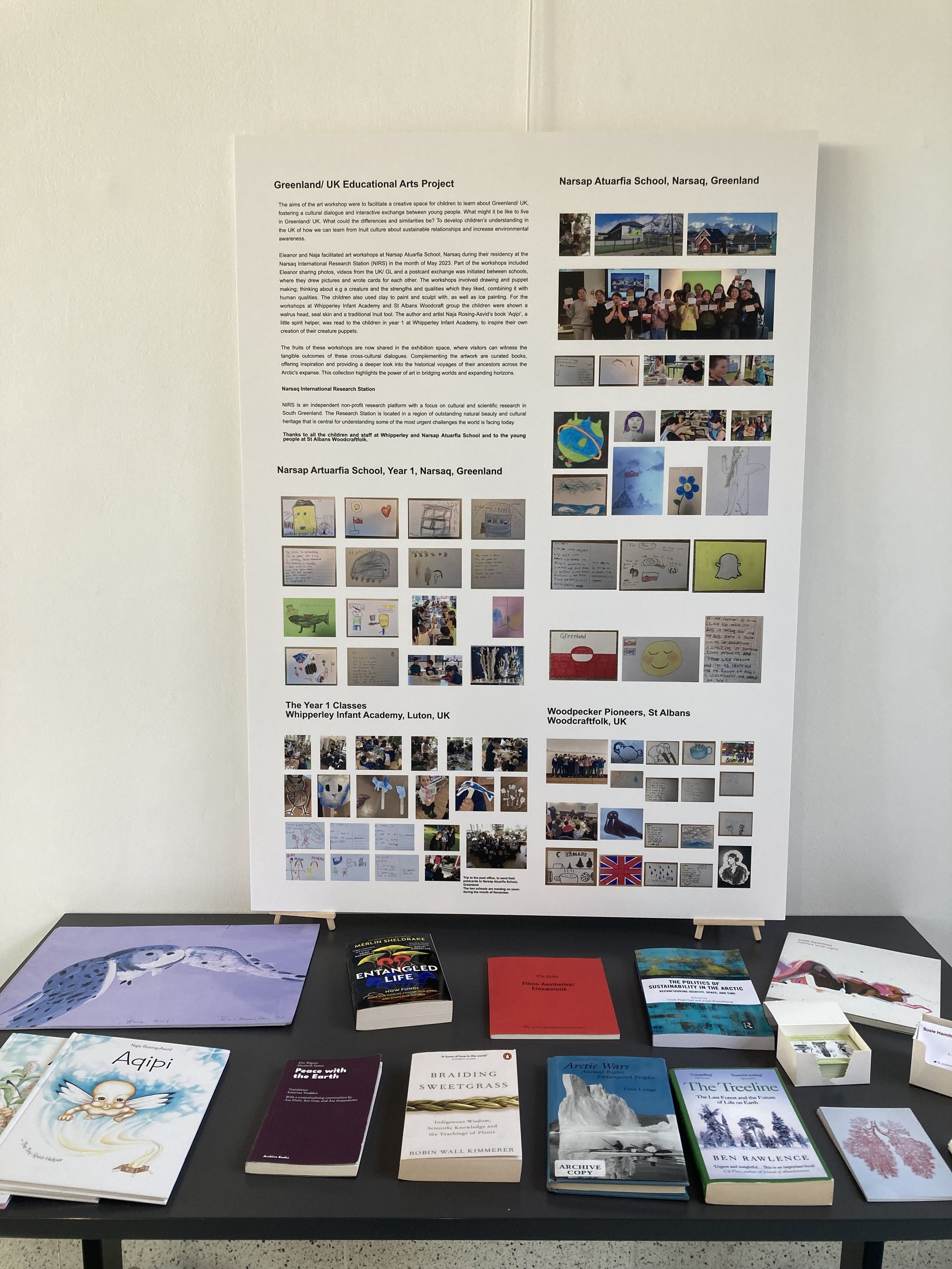
Display of children's workshops and relevant reading at the Royal Geographical Society.
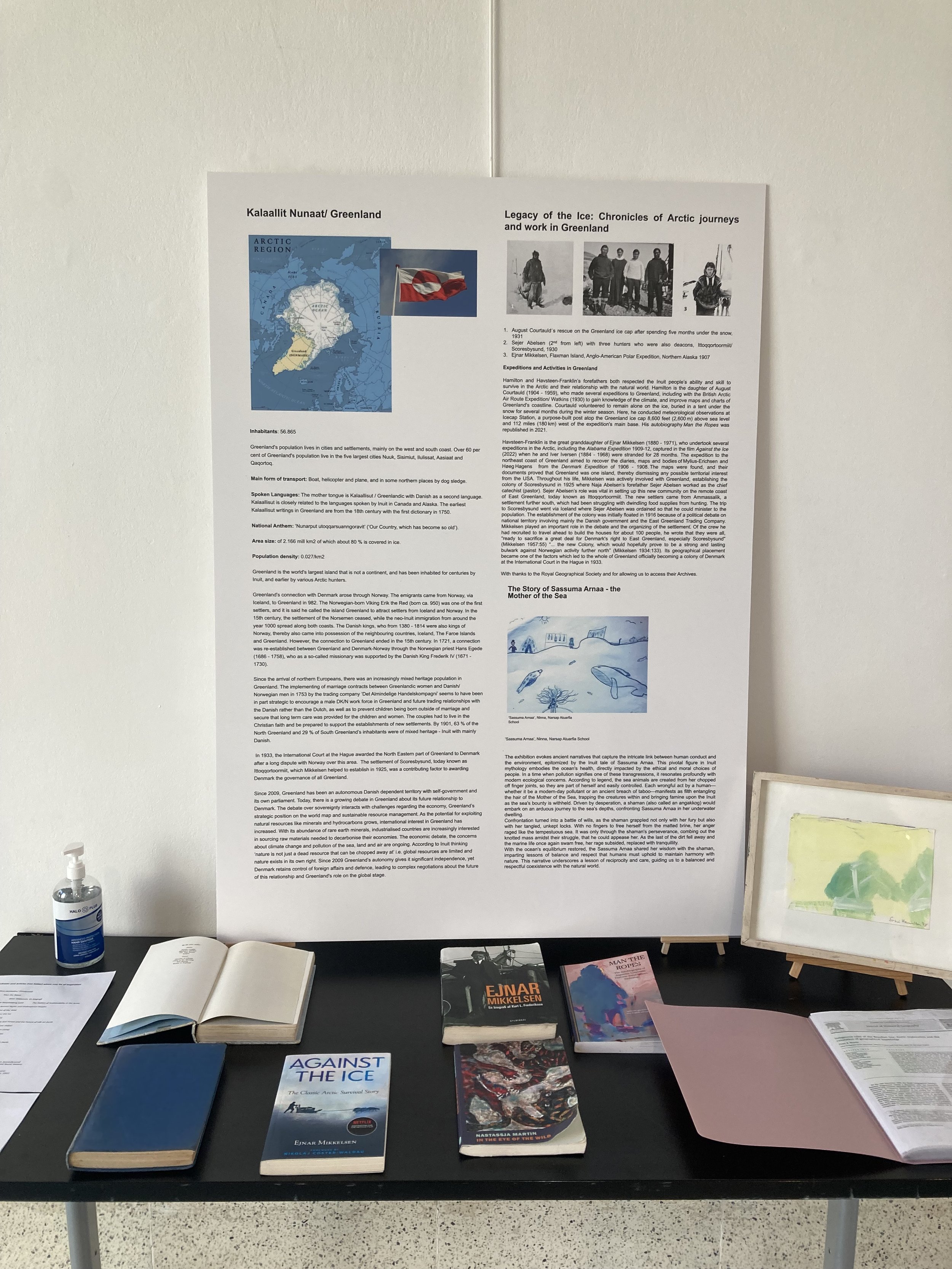
Facts about Greenland and forefathers work in the Arctic, display of Arctic expeditions books and biographies at the Royal Geographical Society.

Meeting with author, artist and curator Naja Rosing-Asvid at Nuuk National Museum and Archive of Greenland. Rosing-Asvid’s books ‘Aqipi’ - the tiny spirit helper' were read to the children in year 1 at Whipperley Infant Academy as part of the cultural exchange and art workshops, to inspire their own creations of small creature puppets.